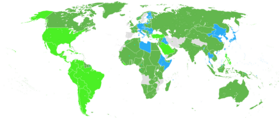Axis Powers of World War II
The Axis powers (German: Achsenmächte, Japanese: 枢軸国 Sūjikukoku, Italian: Potenze dell'Asse), also known as the Rome–Berlin–Tokyo Axis, were the nations that fought in World War II against the Allied Powers. The Axis agreed on their opposition to the Allies, but did not completely coordinate their activity.
The Axis grew out of the diplomatic efforts of Germany, Italy, and Japan to secure their own specific expansionist interests in the mid-1930s. The first step was the treaty signed by Germany and Italy in October 1936. Mussolini declared on 1 November that all other European countries would from then on rotate on the Rome–Berlin axis, thus creating the term "Axis". The almost simultaneous second step was the signing in November 1936 of the Anti-Comintern Pact, an anti-communist treaty between Germany and Japan. Italy joined the Pact in 1937. The "Rome–Berlin Axis" became a military alliance in 1939 under the so-called "Pact of Steel", with the Tripartite Pact of 1940 leading to the integration of the military aims of Germany and its two treaty-bound allies.
At its zenith during World War II, the Axis presided over territories that occupied large parts of Europe, North Africa, and East Asia. There were no three-way summit meetings and cooperation and coordination was minimal, with a bit more between Germany and Italy. The war ended in 1945 with the defeat of the Axis powers and the dissolution of their alliance. As in the case of the Allies, membership of the Axis was fluid, with some nations switching sides or changing their degree of military involvement over the course of the war.
The term "axis" was first applied to the Italo-German relationship by the Italian prime minister Benito Mussolini in September 1923, when he wrote in the preface to Roberto Suster's Germania Repubblica that "there is no doubt that in this moment the axis of European history passes through Berlin" (non v'ha dubbio che in questo momento l'asse della storia europea passa per Berlino). At the time he was seeking an alliance with the Weimar Republic against Yugoslavia and France in the dispute over the Free State of Fiume.
...
Wikipedia

